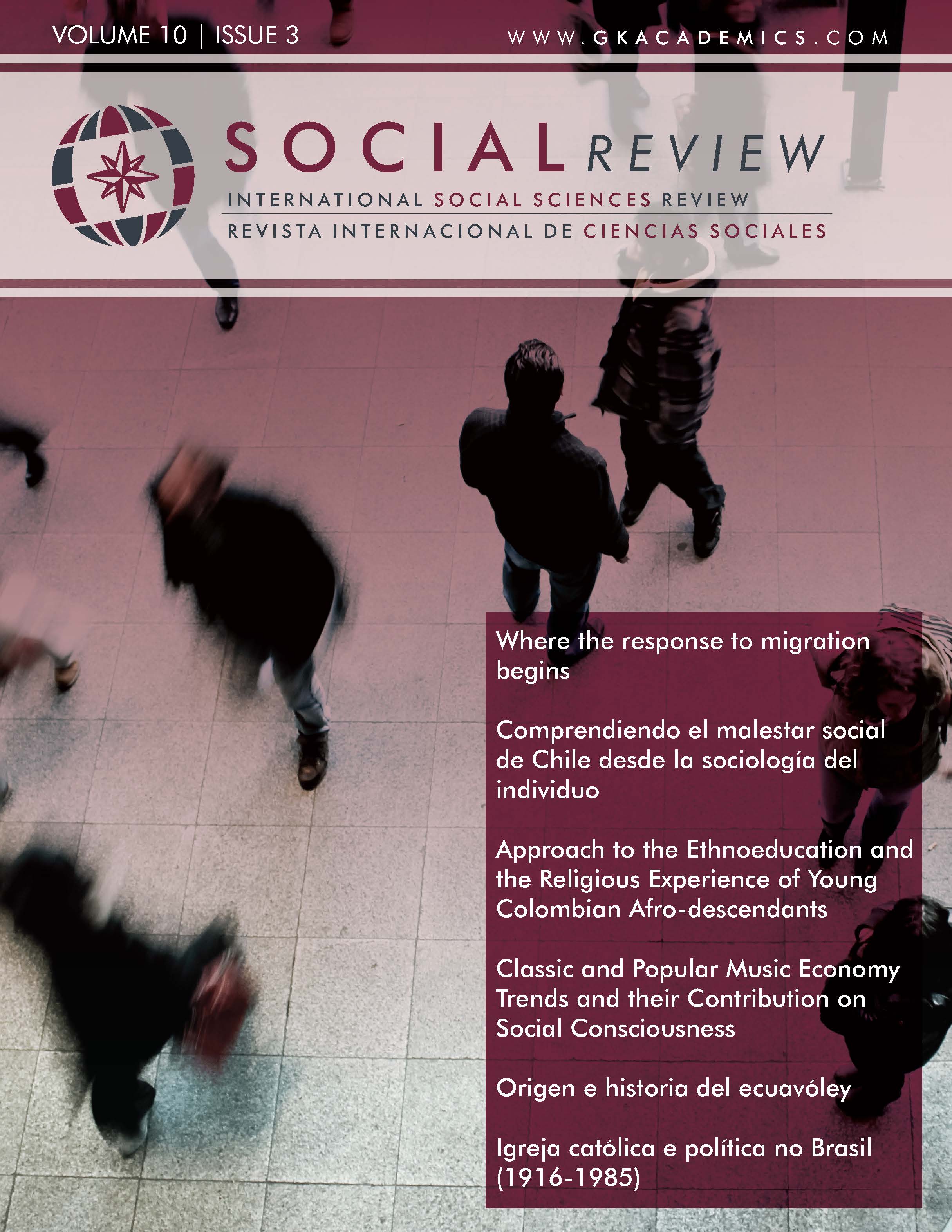Classic and Popular Music Economy Trends and their Contribution on Social Consciousness
DOI:
https://doi.org/10.37467/gkarevsocial.v10.2655Palabras clave:
Current Economical State of Musical Industry, Popular and Classical Music, Cultural and Financial , Value of Music, Society, High and Mass Culture, Social Music ValueResumen
The rise of the subscription services usage as one of the main tools of music consumption, vigorously changed the dynamic of the relationship between the major music corporations and music consumers. Our main emphasis is to consider both popular and classical music industries, the future and reality under the circumstances of the emerging subscription services. The economical aspect of the music industry during the latest years come into clarification for both classical and mainstream. The purpose of this study is to reveal the complete ‘circle’ of the process starting from promotion and distribution to the final stage where we discover how the product influences our society in a global scale.
Descargas
Estadísticas globales ℹ️
|
604
Visualizaciones
|
687
Descargas
|
|
1291
Total
|
|
Citas
Abhilash, K., (2020). Global Online Music Streaming Grew 32% YoY to Cross 350 Million Subscriptions in 2019. Counterpoint. https://www.counterpointresearch.com/global-online-music-streaming-grew-2019/
Adorno, T. W., Frenkel-Brunswik, E., Levinson, D. J., & Stanford, N. R. (1950). The authoritarian personality. Harper & Brothers.
Adorno, W. T. (1999). Sound Figures. Stanford University Press. http://search-ebscohost-com.uaccess.univie.ac.at/login.aspx?direct=true&db=nlebk&AN=2511376&site=ehost-live
Álvarez Vázquez, R. (2017). The Music Industry in The Dawn Of The 21st Century - Networking for a thriving music industry. Kunnskapsverket
Attali, J. (1984). Noise: The Political Economy of Music. University of Minnesota Press.
Baumol, J. W. & Bowen G. W. (1966) Performing arts, the economic dilemma: A study of problems common to theater, opera, music, and dance. Twentieth Century Fund.
Begbie, S. J. (2007) Resounding Truth: Christian Wisdom in the World of Music. Baker Academic.
Benkler, Y. (2006). The wealth of networks: How social production transforms markets and freedom. Yale University Press.
Bowman, W. D. (2002). Why Do Humans Value Music? Philosophy of Music Education Review, 10(1), 55–63.
Daykin, N. (2004). The Role of Music in an Arts-Based Qualitative Inquiry. International Journal of Qualitative Methods, 3(2), 36–44. doi: 10.1177/160940690400300203 DOI: https://doi.org/10.1177/160940690400300203
Denenberg, V. H. (1981). Hemispheric Laterality in Animals and the Effects of Early Experience. Behavioral and Brain Sciences, 4(1), 1–21. doi:10.1017s0140525x00007330 DOI: https://doi.org/10.1017/S0140525X00007330
Guiley, R. (2009) The Encyclopedia of Angels. Facts On File, Inc.
Holt, F. (2010). The economy of live music in the digital age. European Journal of Cultural Studies, 13(2), 243–261. doi: 10.1177/1367549409352277 DOI: https://doi.org/10.1177/1367549409352277
http://www.jstor.org/stable/40327176
https://books.google.com.ua/books?id=SUmHDwAAQBAJ&lpg=PP1&dq=inauthor:"Else Frenkel Brenswik"&hl=ru&pg=PP1#v=onepage&q&f=false
Huffman, C. (2018) Pythagoras. In The Stanford Encyclopedia of Philosophy (E. N. Zalta, Ed.). https://plato.stanford.edu/archives/win2018/entries/pythagoras/
IFPI. (2018). Global Music Report 2018: State Of The Industry (pp. 1–48). https://www.musikindustrie.de/fileadmin/bvmi/upload/06_Publikationen/GMR/GMR2018.pdf
IFPI. (2019). Global Music Report 2019: State Of The Industry (pp. 1–40). https://www.cudisco.org/pdf/GLOBAL-MUSIC%20REPORT-2019.pdf
Kant, I. (1970). Critique of Judgement. Free Press.
Latham, A. (Ed.) (2011). The Oxford Companion to Music. Oxford University Press. https://www.oxfordreference.com/view/10.1093/acref/9780199579037.001.0001/acref-9780199579037
Lebrecht, N. (1997). When the music stops: managers, maestros and the corporate murder of classical music. Simon & Schuster
Leech-Wilkinson, D. (2016). Classical music as enforced Utopia. Arts and Humanities in Higher Education, 15(3-4), 325–336. doi: 10.1177/1474022216647706 DOI: https://doi.org/10.1177/1474022216647706
Levine, L. W. (1993). The Folklore of Industrial Society: Popular Culture and Its Audiences. In The Unpredictable Past: Popular Culture and its Audiences. doi: 10.1093/acprof:oso/9780195082975.001.0001 DOI: https://doi.org/10.1093/acprof:oso/9780195082975.001.0001
Leyshon, A. (2005). On the Reproduction of the Musical Economy after the Internet. Media, Culture & Society, 27(2), 177-209. DOI: https://doi.org/10.1177/0163443705050468
Leyshon, A., Webb, P., French, S., Thrift, N., & Crewe, L. (2005). On the reproduction of the musical economy after the Internet. Media, Culture & Society, 27(2), 177–209. doi: 1.0.1177/0163443705050468 DOI: https://doi.org/10.1177/0163443705050468
Lunney, Glynn S. (October 8, 2012). Copyright’s Mercantilist Turn: Do We Need More Copyright or Less? Tulane Public Law Research Paper No. 12-20. http://dx.doi.org/10.2139/ssrn.2158874 DOI: https://doi.org/10.2139/ssrn.2158874
Maas, E., Hallam, P., & Harris, D. (2012). The Working musician, a research project by DHA Communications. Musicians’ Union. https://musiciansunion.org.uk/working-performing/music-teaching/music-education-reports-and-publications/the-working-musician-report
Macdonald, S. (2009). Greek Philosophy - Simple Guides. Kuperard.
Mason, M. (2009). The pirates dilemma: how youth culture is reinventing capitalism. Free Press.
Mbunda, D., Bosserman, P., Habachi, R., Capriles, O., Zygulski, K., Kirpal, P. (1983). Problems of culture and cultural values in the contemporary world. UNESCO. https://unesdoc.unesco.org/ark:/48223/pf0000054681
McKay, K. F. (2015). A contextual study of Boris Asafiev's Musical form as a process and and application of concepts to his Sonata for solo viola [Thesis, Master of Arts, Western Australian Academy of Performing Arts]. https://ro.ecu.edu.au/theses/1738
MiDiA The Classical Music Market (2019). Steamings Next Genre? https://www.midiaresearch.com/storage/uploads/blog/images/2019/06/MIDiA-Research-IDAGIO-Classical-Music-Market_June19.pdf
Nagano, K. (2019, March 19). In Times of Crisis, We Need Classical Music. The Walrus. https://thewalrus.ca/in-times-of-crisis-we-need-classical-music/
Olkhovsky, A.V. (1955) Music under the Soviets; the agony of an art. F.A. Praeger.
Rainey, L. D. (2002). [Review of The Annals of Lü Buwei, by J. Knoblock & J. Riegel]. American Journal of Chinese Studies, 9(1), 147–150. http://www.jstor.org/stable/44288699
Schroeder F. (2012). Shifting Listening Identities – Towards a Fluidity of Form in Digital Music. In: Broadhurst S., Machon J. (eds) Identity, Performance and Technology. Palgrave Studies in Performance and Technology. Palgrave Macmillan. https://doi.org/10.1057/9781137284440_3 DOI: https://doi.org/10.1057/9781137284440_3
Sellmann, J.(1998). Lushi chunqiu. In The Routledge Encyclopedia of Philosophy. Taylor and Francis. https://www.rep.routledge.com/articles/thematic/lushi-chunqiu/v-1. doi:10.4324/9780415249126-G057-1 DOI: https://doi.org/10.4324/9780415249126-G057-1
Slonimsky, N. (2003). Nicolas Slonimsky: Writings on Music: Russian and Soviet Music and Composers (1st ed.), Routledge. DOI: https://doi.org/10.4324/9780203970294
Spero, J. (2017, August 4). Roll over Beethoven! Classical music and the real gig economy. Financial Times. https://ig.ft.com/sounds/classical-gig-economy.html
Statista. (2019). Share of recorded music industry revenues worldwide in 2020, by segment. https://www.statista.com/statistics/421012/global-music-industry-revenues-source-share/
Statista. (2019). Total revenue of classical recorded music worldwide in 2018, by region (In million U.S. dollars). https://www.statista.com/statistics/1021552/classical-music-revenue-worldwide/
Stensrud, B. (2008, December 9). Classical Music After the CD. The Business of Classical Music. http://businessofclassicalmusic.blogspot.com/2008/12/classical-music-after-cd.html
Vella, J. E., & Mills, G. (2016). Personality, uses of music, and music preference: The influence of openness to experience and extraversion. Psychology of Music, 45(3), 338-354. DOI: 10.1177/0305735616658957 DOI: https://doi.org/10.1177/0305735616658957
Wurth, K.B., & Rigney, A. (2019) Between Elite and Mass Culture. In Life of Texts: An Introduction to Literary Studies, (pp. 273–98) Amsterdam University Press. DOI: https://doi.org/10.1017/9789048551903.009
Xenakis, I., Brown, R., & Rahn, J. (1987). Xenakis on Xenakis. Perspectives of New Music, 25(1/2), 16–63. http://www.jstor.org/stable/833091
Descargas
Publicado
Cómo citar
Número
Sección
Licencia
Los autores/as que publiquen en esta revista aceptan las siguientes condiciones:
- Los autores/as conservan los derechos de autor.
- Los autores/as ceden a la revista el derecho de la primera publicación. La revista también posee los derechos de edición.
- Todos los contenidos publicados se regulan mediante una Licencia Atribución/Reconocimiento-SinDerivados 4.0 Internacional. Acceda a la versión informativa y texto legal de la licencia. En virtud de ello, se permite a terceros utilizar lo publicado siempre que mencionen la autoría del trabajo y a la primera publicación en esta revista. Si transforma el material, no podrá distribuir el trabajo modificado.
- Los autores/as pueden realizar otros acuerdos contractuales independientes y adicionales para la distribución no exclusiva de la versión del artículo publicado en esta revista (p. ej., incluirlo en un repositorio institucional o publicarlo en un libro) siempre que indiquen claramente que el trabajo se publicó por primera vez en esta revista.
- Se permite y recomienda a los autores/as a publicar su trabajo en Internet (por ejemplo en páginas institucionales o personales), una vez publicado en la revista y citando a la misma ya que puede conducir a intercambios productivos y a una mayor y más rápida difusión del trabajo publicado (vea The Effect of Open Access).













